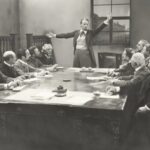Last night my client took the stage at TEDxMidAtlantic. Giving a TEDx talk had been on her bucket list, and the experience is a great addition to her already impressive lineup of speaking engagements and media interviews. She was amazing, she was inspiring and the auditorium was electric with head nods and laughter. (As soon as the clip is available, I will post it here).
As part of her preparation, she watched other TED talks. I often recommend that clients find a few speakers – whether journalists, politicians, business leaders, or TED speakers – to find inspiration as to how others interact with data, move across the stage or gesture. It’s an easy way to pick up some techniques that we later adapt to each speaker’s own presentation persona.
While these talks are often inspiring, they can also be intimidating. The speakers seem not only brilliant, but they make the experience of speaking seem so effortless. They seem… perfect. This tends to undermine my counsel that the best speeches aren’t necessarily the “perfect” ones. A perfect performance can sometimes make the speaker less relatable, if not less likable (and we know that matters). Perfection can distract us from our overall goal of connecting to our audience in a way that inspires action, conveys knowledge, or increases understanding.
Here’s the big truth that I discovered last night; those videos you see on TED.com are heavily edited.*
When TED speakers lose their place, when they’re momentarily at a loss for words or when they go back instead of advancing slides, that’s all removed before the video is shared online.
So while TED and TEDx speakers prepare extensively to make the most of their 20, 15 or even 7 minute segments, they’re not always flawless. What we see online isn’t necessarily what happened. I understand the value in editing for online sharing, though it’s important to know that these minor glitches and missteps probably didn’t take away from the power of their words for those who were in the TED audience.
What can we take away from this newfound truth? Work hard to distill what’s most important for that particular audience at that moment in time. Practice and rehearse so that you’re comfortable with the content and give yourself time to find the right words, the right way to walk across the stage and the hand gestures that feel most natural. But forget perfection. Because even when it seems that way, it might not be.
By the way, my client had a few minor glitches (and only one was probably evident to the audience). She also carried the auditorium and she enjoyed the moment. Based on the chatter during intermission, she made the attendees think twice about some widely held assumptions. We’ll call that a win.
*One of the TEDx volunteers shared this with us as we waited in the Green Room. Please note that as a voracious researcher I’ve probably consumed every book on public speaking, including the half-dozen on how to give a TED talk, so this surprised me. Another side note, the TEDx volunteers are fantastic. They work together as if they were a professional, full-time events team.



